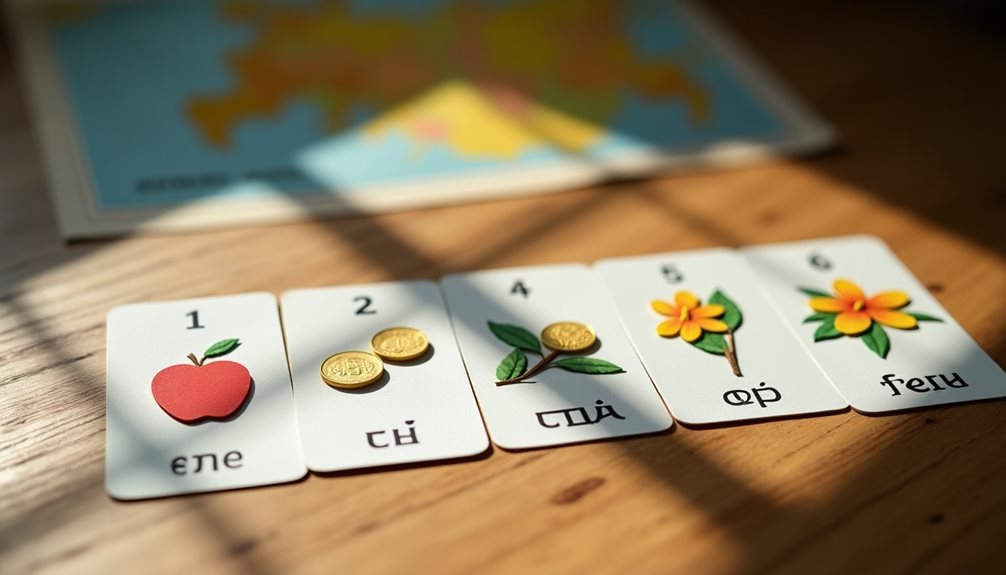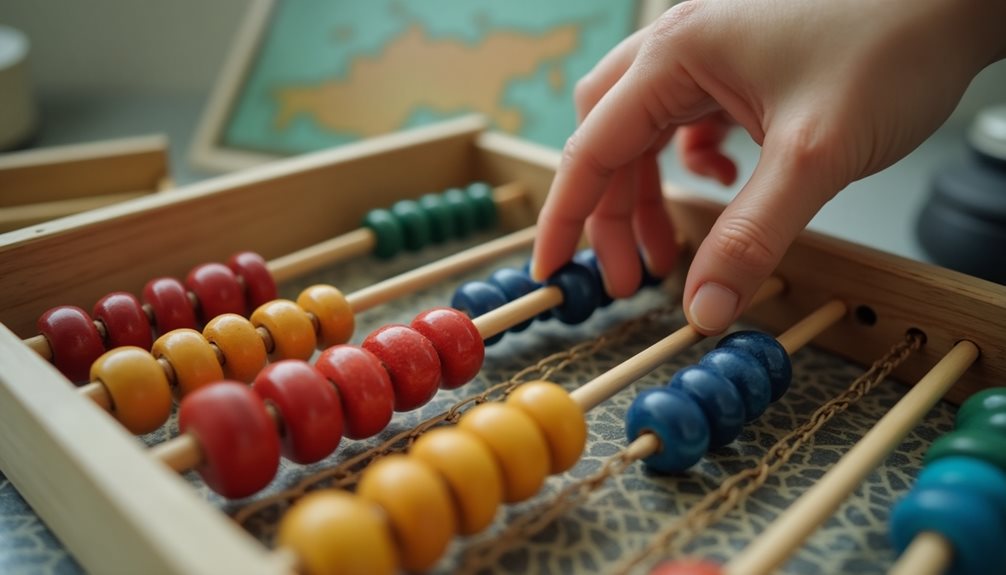Understanding the nuances of Russian numbers is essential for effective communication. Each cardinal number varies based on gender and case, impacting how they interact with nouns. For example, “один” transforms in the genitive case, while “два” presents a distinct feminine form. Such complexities demand careful attention to detail. As one navigates these grammatical intricacies, the implications for clarity and accuracy become evident, prompting further exploration into specific rules and exceptions.
![]()
Table of Contents
ToggleThe Basics of Russian Numbers

Understanding the fundamentals of Russian numbers is essential for anyone looking to master the language. Russian numbering systems can be categorized into two primary types: cardinal and ordinal. Cardinal numbers denote quantity, serving as the foundation for counting, while ordinal numbers indicate position or order within a sequence. This distinction is vital for effective communication, as it shapes how information is conveyed.
Additionally, Russian employs unique counting systems that differ from those in other languages, incorporating gender and case rules that affect numerical forms. Mastery of these systems enables learners to navigate everyday contexts, such as shopping or scheduling, enhancing their linguistic competence.
Familiarity with cardinal vs ordinal numbers forms the bedrock of an extensive understanding of Russian numeration.
Cardinal Numbers and Their Usage
Cardinal numbers in Russian play an essential role in everyday communication, as they quantify objects, indicate age, and specify amounts in various contexts. Understanding cardinal number rules is crucial for effective communication.
For instance, the number one (один) changes form based on the gender of the noun it modifies, while other numbers remain unchanged. Their usage in sentences varies; for example, “У меня три книги” (I have three books) illustrates quantity, whereas “Ему двадцать лет” (He is twenty years old) indicates age.
Cardinal numbers are basic number words used to count things (like one, two, three) or show amounts. In Russian, they are used in many everyday situations such as telling your age, saying how many things you have, talking about prices, or telling the time. Understanding how to use them will help you speak and understand Russian much better.
Key Points About Cardinal Numbers in Russian
1. Gender Agreement for “One”
- The number “one” changes depending on the gender of the noun it describes.
- Masculine: один (a-deen)
- Feminine: одна (ad-na)
- Neuter: одно (ad-no)
- Plural (used with some countable nouns): одни (ad-nee)
Example:
- Один стол (a-deen stol) — One table (table is masculine)
- Одна книга (ad-na kniga) — One book (book is feminine)
- Одно окно (ad-no okno) — One window (window is neuter)
![]()
2. Numbers 2, 3, and 4 Also Change
- These numbers also change slightly for masculine and feminine nouns:
- 2: два (dva, masculine/neuter), две (dvye, feminine)
- 3: три (tree, same for all genders)
- 4: четыре (chee-ty-re, same for all genders)
Example:
- Два стула (dva stula) — Two chairs (chairs are masculine)
- Две лампы (dvye lampy) — Two lamps (lamps are feminine)
![]()
3. Numbers After Four
- The rest of the numbers stay the same, no matter the gender of the noun.
4. Using Numbers with Nouns
- After 1: the noun is in nominative singular.
- одна машина (one car)
- After 2, 3, 4: the noun is in genitive singular.
- три книги (three books)
- After 5 and higher: the noun is in genitive plural.
- пять книг (five books)
![]()
5. Expressing Age
- Use the number plus the word “лет” (let, years).
- Мне двадцать лет. (Mnye dvadtsat’ let.) — I am twenty years old.
6. Counting and Prices
- Numbers are used to count and talk about money.
- У меня пять рублей. (U menya pyat’ rubley.) — I have five rubles.
7. Telling Time
- Numbers are used for hours and minutes.
- Сейчас три часа. (Seichas tree chasa.) — It’s three o’clock.
Russian Cardinal Numbers Table
| Cyrillic | Phonetic | English Meaning |
|---|---|---|
| один | a-deen | one |
| одна | ad-na | one (feminine) |
| одно | ad-no | one (neuter) |
| два | dva | two |
| две | dvye | two (feminine) |
| три | tree | three |
| четыре | chee-ty-re | four |
| пять | pyat’ | five |
| шесть | shest’ | six |
| семь | syem’ | seven |
| восемь | vo-syem’ | eight |
| девять | dye-vyat’ | nine |
| десять | dye-syat’ | ten |
| двадцать | dvad-tsat’ | twenty |
| тридцать | treed-tsat’ | thirty |
| сорок | so-rok | forty |
| пятьдесят | pyat’-dee-syat | fifty |
| сто | sto | one hundred |
Example Sentences
- У меня один брат.
(U menya a-deen brat.)
I have one brother. - Она купила две книги.
(Ona kupila dvye knigi.)
She bought two books. - На столе три яблока.
(Na stole tree yabloka.)
There are three apples on the table. - Мне пятнадцать лет.
(Mne pyat-nad-tsat’ let.)
I am fifteen years old.
Tips for Learners
- Always check the gender of the noun when using numbers 1 and 2.
- For numbers after four, use the genitive plural form of the noun.
- Practice counting everyday objects around you in Russian.
Ordinal Numbers Explained
Ordinal numbers in Russian serve to indicate the position or sequence of items rather than their quantity. Their formation typically involves modifying cardinal numbers, often through the addition of specific suffixes. For instance, the cardinal number один (one) becomes первый (first), while два (two) transforms into второй (second).
The usage of ordinal numbers is vital in various contexts, such as dates, rankings, and lists. They provide clarity when discussing order, often appearing in both written and spoken language.
Understanding how to properly form and use these numbers allows for effective communication in Russian, facilitating the expression of sequences and rankings in everyday situations. This knowledge is significant for learners aiming to navigate social and academic environments with ease.
Russian ordinal numbers are usually formed by modifying the basic cardinal numbers (one, two, three, etc.) with specific endings. These endings match the gender, number (singular/plural), and case of the noun they describe. This is different from English, where you just use “first,” “second,” “third,” etc., no matter what you’re describing.
Key Points:
- Gender Agreement: Ordinal numbers must match the noun’s gender (masculine, feminine, neuter).
- Case Agreement: They also change depending on the noun’s case (nominative, accusative, etc.).
- Suffixes: Common suffixes include -ый, -ий, -ой (masculine), -ая (feminine), -ое (neuter).
Common Ordinal Numbers: Examples
| Cardinal | Ordinal (Masc.) | Phonetic | English Meaning |
|---|---|---|---|
| один | первый | PYER-viy | first |
| два | второй | fta-ROY | second |
| три | третий | TRYET-iy | third |
| четыре | четвёртый | chit-VYOR-tiy | fourth |
| пять | пятый | PYAT-iy | fifth |
| шесть | шестой | shes-TOY | sixth |
| семь | седьмой | sed’-MOY | seventh |
| восемь | восьмой | vas’-MOY | eighth |
| девять | девятый | dye-VYA-tiy | ninth |
| десять | десятый | dye-SYA-tiy | tenth |
Gender and Case Examples
Let’s see how ordinal numbers change with gender:
- Masculine: первый день (PYER-viy dyen’) — first day
- Feminine: первая неделя (PYER-vaya nee-DYE-lya) — first week
- Neuter: первое место (PYER-voye MYE-sta) — first place
Using Ordinal Numbers in Sentences
- Я живу на втором этаже.
(ya zhee-VOO na fta-ROM eh-ta-ZHE)
I live on the second floor. - Это моя третья книга.
(EH-ta ma-YA TRYET-ya KNEE-ga)
This is my third book. - Он занял первое место.
(On ZA-nyal PYER-vo-ye MYE-sta)
He took first place.
Related Russian Terms
| Russian (Cyrillic) | Phonetic | English Definition |
|---|---|---|
| порядковый номер | pa-RYAD-ka-viy NO-mer | ordinal number |
| число | chee-SLO | number |
| первый | PYER-viy | first |
| второй | fta-ROY | second |
| третий | TRYET-iy | third |
| место | MYE-sta | place |
| этаж | eh-taZH | floor (of a building) |
| неделя | nee-DYE-lya | week |
Tips for Remembering Russian Ordinals
Learning Russian ordinal numbers can be tricky, but with the right approach, you can master them!
1. Practice with Real Items
Use real-life objects around you to practice ordinals in Russian. For example:
- “the first apple” — первое яблоко (pyer-vo-ye YAB-lo-ko)
- “the second book” — вторая книга (vta-RA-ya KNEE-ga)
Try labeling things in your room or making simple sentences:
- The third chair — третьий стул (TRYET-yee STOOL)
- The fourth plate — четвёртая тарелка (cheet-VYOR-ta-ya ta-RYEL-ka)
2. Pay Attention to Gender
In Russian, adjectives and ordinal numbers must match the gender of the noun:
| Noun Gender | Example Ordinal (“first”) | Russian | Phonetic | Example Noun | English Translation |
|---|---|---|---|---|---|
| Masculine | первый | первый | PYER-viy | стул | chair |
| Feminine | первая | первая | PYER-va-ya | книга | book |
| Neuter | первое | первое | PYER-vo-ye | яблоко | apple |
| Plural | первые | первые | PYER-vye | дома | houses |
Always check the noun’s gender before choosing the ending!
3. Learn the Irregulars
Some Russian ordinals don’t follow the pattern you might expect. The most important irregulars are:
| English | Cyrillic | Phonetic |
|---|---|---|
| first | первый | PYER-viy |
| second | второй | vta-ROY |
| third | третий | TRYET-yee |
| fourth | четвёртый | cheet-VYOR-tiy |
| fifth | пятый | PYA-tiy |
Note: “Первый” and “третий” look quite different from their cardinal forms (один = one, три = three).
4. Practice Makes Perfect
Make simple sentences to reinforce what you learn:
- My first friend — мой первый друг (moy PYER-viy droog)
- Her second dress — её второе платье (ye-YO vta-RO-ye PLAT-ye)
5. Common Russian Ordinals Table
Here’s a helpful reference table for the first five ordinals in Russian:
| English Order | Cyrillic | Phonetic | English Definition |
|---|---|---|---|
| First | первый | PYER-viy | first (masculine) |
| First | первая | PYER-va-ya | first (feminine) |
| First | первое | PYER-vo-ye | first (neuter) |
| Second | второй | vta-ROY | second (masculine) |
| Third | третий | TRYET-yee | third (masculine) |
| Fourth | четвёртый | cheet-VYOR-tiy | fourth (masculine) |
| Fifth | пятый | PYA-tiy | fifth (masculine) |
You can adjust endings for gender and number as needed.
Quick Tips:
- Practice aloud—Russian pronunciation improves with repetition.
- Write out lists of items in order to get used to changing endings.
- Focus on the most common ordinals at first.
Agreement Between Numbers and Nouns
In Russian, the agreement between numbers and nouns is essential for grammatical accuracy and coherence in communication. This number agreement dictates that the form of the noun must align with the numerical value being expressed.
For instance, the declension of nouns changes based on the quantity, with specific endings corresponding to different numbers. Singular nouns typically follow the rules for one, while plural forms are used for numbers two through four, and the genitive plural is used for five and higher.
Understanding how numbers and nouns agree in Russian is crucial for anyone learning the language. Unlike English, Russian nouns change their forms depending on the number they are associated with. This system can seem complex at first, but breaking it down into clear rules and examples makes it much easier to grasp.
Key Rules of Number and Noun Agreement
1. The Number “One” (Один)
- Rule: The noun takes the nominative singular form.
- Example:
- 1 книга (odna kniga) — one book
- 1 стол (odin stol) — one table
2. Numbers “Two,” “Three,” and “Four” (Два, Три, Четыре)
- Rule: The noun takes the genitive singular form.
- Example:
- 2 книги (dve knigi) — two books
- 3 стола (tri stola) — three tables
- 4 окна (chetyre okna) — four windows
3. Numbers “Five” and Above (Пять и больше)
- Rule: The noun takes the genitive plural form.
- Example:
- 5 книг (pyat’ knig) — five books
- 7 столов (sem’ stolov) — seven tables
- 10 окон (desyat’ okon) — ten windows
4. Zero and Compound Numbers
- Rule: Numbers ending in 5–9, 0, or any number from 11 to 14 use the genitive plural.
- Example:
- 0 книг (nul’ knig) — zero books
- 11 стульев (odinnadtsat’ stul’yev) — eleven chairs
- 23 книги (dvadtsat’ tri knigi) — twenty-three books
Special Notes
- The agreement applies regardless of gender or animacy of the noun.
- The endings often change not just for the noun, but sometimes for adjectives and pronouns as well.
Common Russian Terms: Numbers and Noun Agreement
| Russian (Cyrillic) | Phonetic | English Definition |
|---|---|---|
| один | odin | one |
| два | dva | two |
| три | tree | three |
| четыре | chetyre | four |
| пять | pyat’ | five |
| книга | kniga | book |
| стол | stol | table |
| окно | okno | window |
| столов | stolov | (of) tables (genitive plural) |
| книг | knig | (of) books (genitive plural) |
| окон | okon | (of) windows (genitive plural) |
| стола | stola | (of) table (genitive singular) |
| книги | knigi | (of) book (genitive singular/plural) |
Numbers in Different Cases
Understanding how numbers function in different grammatical cases is essential for accurate communication in Russian. Numbers in Russian exhibit variations based on their grammatical case, necessitating an understanding of number genders and numeral agreement.
For instance, in the nominative case, the forms of numbers may differ from those in the genitive or accusative cases. This variation reflects not only the grammatical context but also the gender of the nouns with which they are used.
The agreement between numbers and the nouns they modify is critical; masculine, feminine, and neuter nouns require corresponding forms of numerals. Mastery of these distinctions allows for precise expression, enriching one’s command of the Russian language while ensuring clarity in communication.
For example, “one cat” in Russian is “один кот” (masculine), but “one book” is “одна книга” (feminine), showing how the number changes to match the noun’s gender.
Special Cases and Exceptions

While many rules govern the use of numbers in Russian, certain special cases and exceptions can complicate the application of these rules. Understanding these nuances is essential for achieving fluency. Significantly, some numbers trigger specific grammatical behaviors that deviate from standard patterns.
| Special Rule | Number Exception |
|---|---|
| 1 and 2 in the genitive | Use “одного” and “двух” |
| 5-20 in the genitive | Use plural forms |
| “два” and “две” | Gender distinction |
| “три” and “четыре” | Plural case usage |
| Hundreds and thousands | Unique declension |
These special rules showcase the complexity of Russian numerology and its reliance on context, accentuating the importance of mastering these number exceptions for effective communication.
Quiz Time: Test Your Memory
Question 1
Which form of the noun should you use after the number “4” in Russian?
A) Nominative singular
B) Genitive singular
C) Genitive plural
Correct Answer:
B) Genitive singular
Question 2
What is the correct feminine form of the number “two” in Russian?
A) два (dva)
B) две (dvye)
C) двое (dvoye)
Correct Answer:
B) две (dvye)
Question 3
How does the Russian ordinal number for “first” change with the gender of the noun?
A) It doesn’t change at all
B) It only changes for masculine and feminine nouns
C) It changes for masculine, feminine, neuter, and plural nouns
Correct Answer:
C) It changes for masculine, feminine, neuter, and plural nouns
Practical Examples and Exercises
To effectively grasp the intricacies of Russian numbers, practical examples and exercises serve as essential tools for learners. Engaging in counting practice enhances both comprehension and confidence in number pronunciation.
For instance, learners can practice by counting everyday objects in Russian, such as books or apples, reinforcing their understanding of numeral forms and cases. Additionally, interactive drills, such as role-playing shopping scenarios, can further solidify learners’ grasp of numerical contexts.
Regularly incorporating these exercises into study routines not only improves retention but also fosters fluency. By systematically applying these practical examples, learners can navigate the complexities of Russian numbers with greater ease and adapt their skills for real-life situations, promoting a sense of freedom in their language use.
Frequently Asked Questions
How Do Russian Numbers Differ From English Numbers?
Russian numbers exhibit distinct characteristics compared to English numbers, particularly in their use of cardinal and ordinal forms. The grammatical structures and gender agreements in Russian introduce complexities absent in English, necessitating careful attention to context and usage.
Are There Dialectal Variations in Russian Number Usage?
Dialectal variations in Russian number usage reveal significant regional differences, particularly in colloquial usage. These differences can affect pronunciation, grammatical forms, and even numerical expressions, showcasing the rich linguistic diversity present across the Russian-speaking population.
Can Numbers Be Used in Poetry or Literature Differently?
Numbers in poetry and literature serve as powerful literary symbolism, often enhancing thematic depth. Their incorporation into rhythmic patterns can evoke emotions, create tension, and establish connections, allowing authors to explore complex ideas through numerical representation and structure.
What Resources Can Help With Learning Russian Numbers?
Various resources facilitate learning Russian numbers, including apps and websites, textbooks and workbooks, online courses, and language exchange platforms. Each resource offers unique approaches, catering to diverse learning styles and promoting language acquisition effectively.
How Do Numbers Affect Sentence Structure in Russian?
In Russian, numbers influence sentence structure considerably. Number agreement dictates that nouns must align with number forms, while case endings adjust according to grammatical roles, ensuring clarity and coherence within the sentence framework. This complexity enriches expression.



